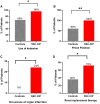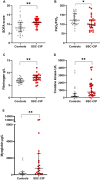Hepatobiliary long-term consequences of COVID-19: dramatically increased rate of secondary sclerosing cholangitis in critically ill COVID-19 patients
- PMID: 37119516
- PMCID: PMC10148013
- DOI: 10.1007/s12072-023-10521-0
Hepatobiliary long-term consequences of COVID-19: dramatically increased rate of secondary sclerosing cholangitis in critically ill COVID-19 patients
Abstract
Background: Increasing evidence suggests that secondary sclerosing cholangitis (SSC), which can lead to cirrhosis or liver failure, may be a hepatobiliary long-term complication of COVID-19. The aim of this study was to estimate the frequency and outcome of this COVID-19 sequela and to identify possible risk factors.
Methods: This observational study, conducted at University Hospital Charité Berlin and Unfallkrankenhaus Berlin, Germany, involved hospitalized patients with COVID-19 pneumonia, including 1082 ventilated COVID-19 patients. We compared COVID-19 patients who developed SSC with a COVID-19 control group by univariate and multivariate analyses.
Results: SSC occurrence after COVID-19 was observed exclusively in critically ill patients with invasive ventilation, albeit with extreme clustering among them. One in every 43 invasively ventilated COVID-19 patients developed this complication. Risk factors preceding the development of secondary sclerosing cholangitis in critically ill COVID-19 patients (SSC-CIP) were signs of systemic reduced blood oxygen supply (e.g., low PaO2/FiO2, ischemic organ infarctions), multi-organ failure (high SOFA score) at admission, high fibrinogen levels and intravenous ketamine use. Multivariate analysis confirmed fibrinogen and increased plasma lactate dehydrogenase as independent risk factors associated with cholangiopathy onset. The 1-year transplant-free survival rate of COVID-19-associated SSC-CIP was 40%.
Conclusions: COVID-19 causes SSC-CIP in a substantial proportion of critically ill patients. SSC-CIP most likely develops due to severe tissue hypoxia and fibrinogen-associated circulatory disturbances. A significant increase of patients with SSC-CIP is to be expected in the post-COVID era.
Keywords: COVID-19 associated SSC-CIP; COVID-19 cholangiopathy; COVID-19 long-term consequences; Ischemic cholangiopathy; Secondary sclerosing cholangitis in critically ill patients.
© 2023. The Author(s).
Conflict of interest statement
The authors (Silke Leonhardt, Christian Jürgensen, Josephine Frohme, Donata Grajecki, Andreas Adler, Michael Sigal, Julia Leonhardt, Julian M. Voll, Jan Matthias Kruse, Roland Körner, Kai‑Uwe Eckardt, Hans‑Joachim Janssen, Volker Gebhardt, Marc D. Schmittner, Pa-COVID-19 collaborative study group, Christian Frey, Hendrik Müller‑Ide, Michael Bauer, Charlotte Thibeault, Florian Kurth, Leif Erik Sander, Tobias Müller and ·Frank Tacke) declare that they have no conflict of interest. None of the authors or coauthors has a financial interest in any of the products, devices, or drugs mentioned in this manuscript.
Figures



Comment in
-
"Dosis sola facit venenum"-Evidence for causality in the association between ketamine and cholestatic liver injury.Hepatol Int. 2024 Jun;18(3):1056-1057. doi: 10.1007/s12072-024-10646-w. Epub 2024 Mar 13. Hepatol Int. 2024. PMID: 38472608 Free PMC article. No abstract available.
References
Publication types
MeSH terms
Substances
Grants and funding
LinkOut - more resources
Full Text Sources
Medical

